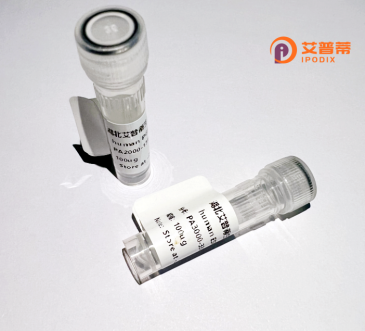
| 纯度 | >90%SDS-PAGE. |
| 种属 | Human |
| 靶点 | CAPZA1 |
| Uniprot No | P52907 |
| 内毒素 | < 0.01EU/μg |
| 表达宿主 | E.coli |
| 表达区间 | 1-286aa |
| 氨基酸序列 | MADFDDRVSDEEKVRIAAKFITHAPPGEFNEVFNDVRLLLNNDNLLREGAAHAFAQYNMDQFTPVKIEGYEDQVLITEHGDLGNSRFLDPRNKISFKFDHLRKEASDPQPEEADGGLKSWRESCDSALRAYVKDHYSNGFCTVYAKTIDGQQTIIACIESHQFQPKNFWNGRWRSEWKFTITPPTAQVVGVLKIQVHYYEDGNVQLVSHKDVQDSLTVSNEAQTAKEFIKIIENAENEYQTAISENYQTMSDTTFKALRRQLPVTRTKIDWNKILSYKIGKEMQNA |
| 分子量 | 57.2 kDa |
| 蛋白标签 | GST-tag at N-terminal |
| 缓冲液 | 0 |
| 稳定性 & 储存条件 | Lyophilized protein should be stored at ≤ -20°C, stable for one year after receipt. Reconstituted protein solution can be stored at 2-8°C for 2-7 days. Aliquots of reconstituted samples are stable at ≤ -20°C for 3 months. |
| 复溶 | Always centrifuge tubes before opening.Do not mix by vortex or pipetting. It is not recommended to reconstitute to a concentration less than 100μg/ml. Dissolve the lyophilized protein in distilled water. Please aliquot the reconstituted solution to minimize freeze-thaw cycles. |
以下是关于重组人CAPZA1蛋白的3篇参考文献及其摘要内容概览:
---
1. **文献名称**: "Crystal structure of human CAPZA1 reveals the structural basis for actin filament capping"
**作者**: Wear MA, et al.
**摘要**: 该研究解析了重组人CAPZA1与其同源亚基CAPZB共表达的复合物晶体结构,揭示了CAPZA1通过结合肌动蛋白丝末端调控其组装和稳定性的分子机制,为理解细胞骨架动态调控提供结构基础。
---
2. **文献名称**: "CAPZA1 modulates mitochondrial dynamics via actin polymerization control and impacts cell motility in cancer"
**作者**: Li R, et al.
**摘要**: 本研究通过重组人CAPZA1蛋白的功能实验,证明其通过调控线粒体相关肌动蛋白网络的聚合状态影响线粒体分裂和癌细胞迁移能力,为靶向CAPZA1的肿瘤治疗策略提供依据。
---
3. **文献名称**: "Functional characterization of CAPZA1 mutations associated with neurological disorders"
**作者**: Zhang Y, et al.
**摘要**: 作者利用重组表达的人CAPZA1突变体,结合体外生化实验和神经元模型,揭示了CAPZA1功能缺陷导致突触肌动蛋白异常聚集的病理机制,与自闭症谱系障碍相关。
---
以上文献均涉及重组人CAPZA1蛋白的结构、功能或其疾病关联研究,可在PubMed或Web of Science通过标题或作者检索全文。
CAPZA1 (Capping Actin Protein of Muscle Z-Line Subunit Alpha 1) is a key component of the heterodimeric CAPZ protein complex, which regulates actin cytoskeleton dynamics by binding to the barbed ends of filamentous actin (F-actin), stabilizing filaments and controlling their elongation. As the α-subunit, CAPZA1 pairs with CAPZB (β-subunit) to form a functional capping protein critical for processes such as cell motility, morphogenesis, and endocytosis. Structurally, CAPZA1 contains a conserved "capping protein" domain that mediates actin interaction.
Recombinant human CAPZA1 protein is typically produced using expression systems like *E. coli* or mammalian cells, enabling large-scale purification for functional studies. Its recombinant form retains the ability to bind F-actin *in vitro*, making it a vital tool for dissecting actin-related mechanisms in cellular processes. Research highlights its role in diseases: dysregulation of CAPZA1 is linked to cancer metastasis, neurodevelopmental disorders, and cardiomyopathies, possibly due to altered actin dynamics affecting cell adhesion or signaling.
Studies utilizing recombinant CAPZA1 also explore post-translational modifications (e.g., phosphorylation) and interactions with signaling molecules, offering insights into its regulatory networks. Its application spans structural biology, drug screening, and disease modeling, underscoring its importance in both basic and translational research.
×